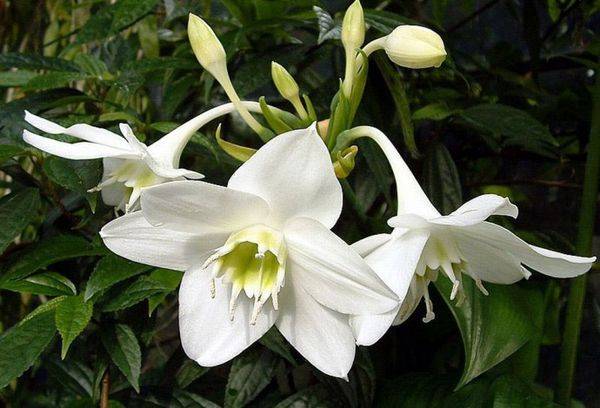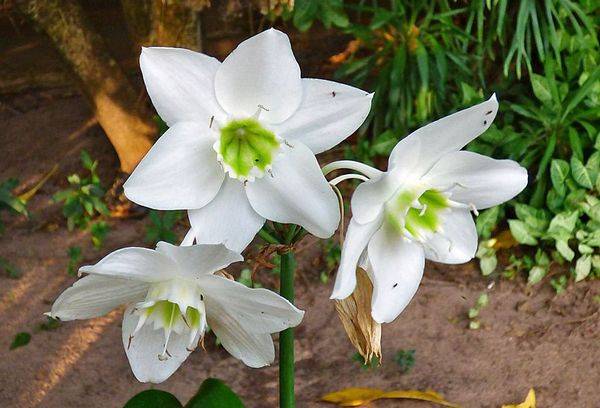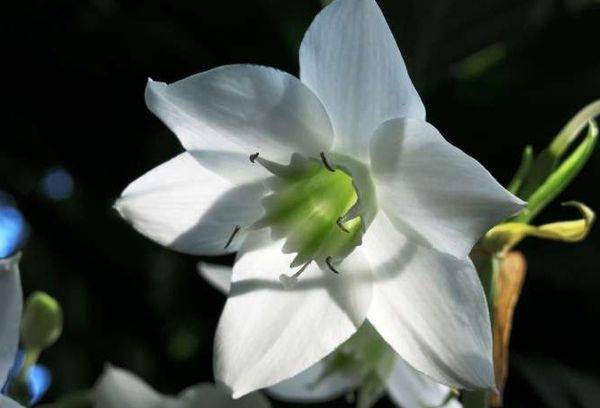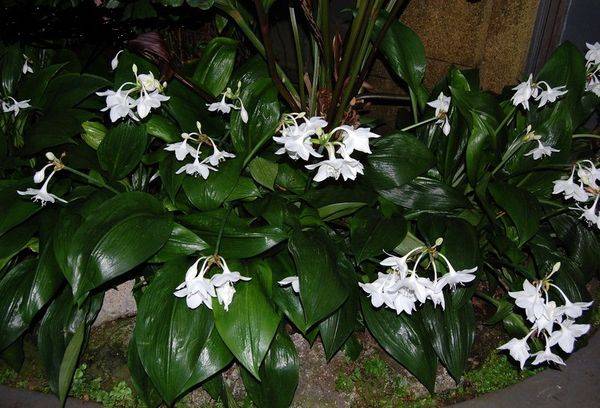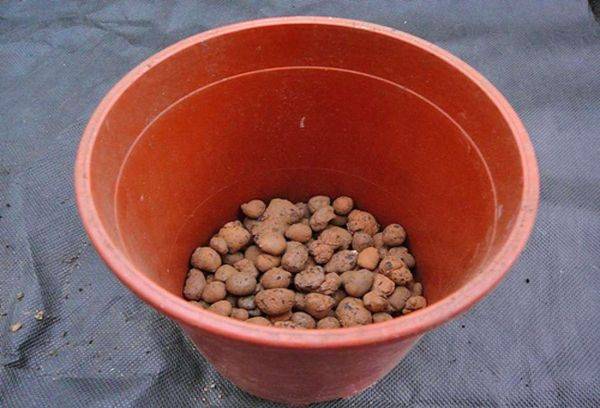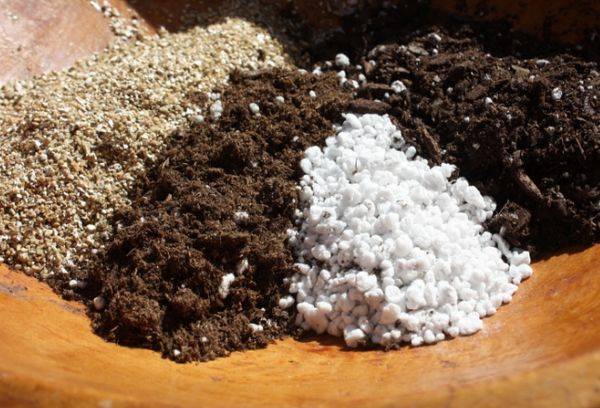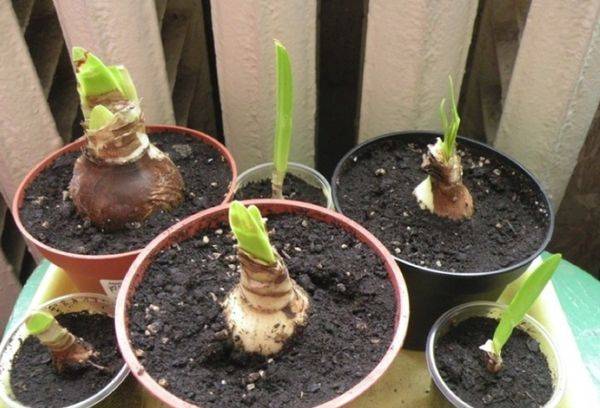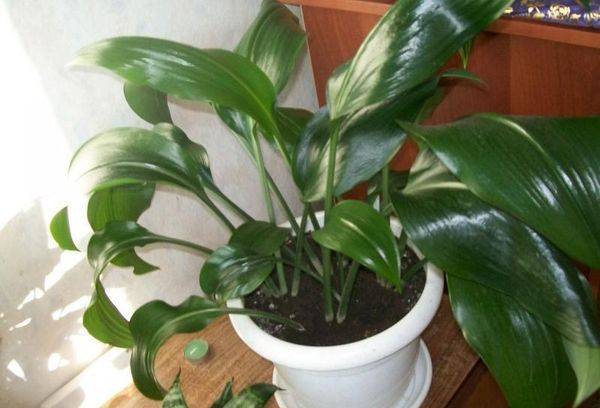Proper care of eucharis at home
Content:
The flowers of this indoor plant seem to be made of the most delicate snow-white porcelain and are distinguished by their exquisite matte finish. The noble beauty of the flowers is emphasized by large leaves of a deep green hue. The plant is called eucharis - caring for it indoors is not difficult, but it requires knowledge of the basic rules and the creation of optimal conditions.
Description
Eucharis is a bulbous plant; its underground shoot is spherical in shape and grows up to 6 cm in diameter. The flower's homeland is the tropics of Central and South America, the lower tier of the evergreen forest.
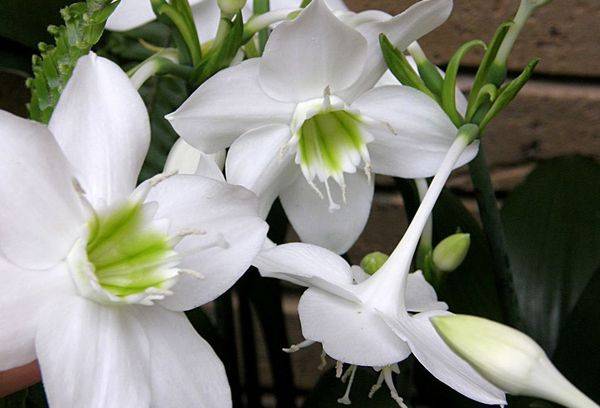
The flowers are very similar in appearance to daffodils: spectacular, large in size - up to 12 cm in diameter, collected several pieces (3-10) in inflorescences, snow-white, with an exquisite, pleasant aroma. The flowers are located on a peduncle, which sometimes extends up to 60 cm.
Eucharis leaves are dark green, lanceolate, reach 55 cm in length and 20 cm in width. Longitudinal veins protrude above the surface of the leaf blade.
A well-groomed Eucharis grandiflora plant is full of grace and majestic beauty; it blooms twice a year - in late autumn (winter) and in spring.Eucharis remains decorative even between flowerings - thanks to the beautiful leaves that the plant never completely loses. Complete loss of leaves is usually a consequence of improper living conditions or stress.
Advice
Losing leaves is a difficult test for eucharis, for this reason the remaining bulb is forced to germinate as soon as possible in a warm place.
Kinds
The genus Eucharis belongs to the Amaryllis family and has approximately 20 species, but only a few of them have become widespread in indoor floriculture:
- Eucharis Sandera — a distinctive feature of the species are snow-white flowers, which in shape are more reminiscent of lilies than daffodils.
- Eucharis snow-white. On one peduncle of the plant there are about ten small white flowers with petals slightly bent back. The apical part of the flowers has yellow inclusions.
- Eucharis grandiflora. This species is otherwise called the Amazon lily. On one inflorescence there are 5-6 flowers, reminiscent of daffodils in appearance. E. grandiflora is most popular among flower growers, since caring for it at home is easy. Compliance with all recommendations ensures the plant blooms in August and March.
Caring for eucharis is quite simple; even a novice gardener can cope with all the activities. Despite its tropical origin, the plant is not particularly demanding of its living conditions.
Lighting and temperature conditions
For good development, the flower needs bright diffused light at least 3-4 hours a day. The window sill of a window facing east or west is perfect for creating such conditions.In the summer months, the plant must be shaded from the scorching midday rays.
The period of active growth of eucharis occurs in the summer; the optimal temperature regime will be in the range from +20 to +25˚ C. From November to January, the thermometer in the room where the eucharis is located should not fall below +13 and rise above +15˚ C. Later comes the time for the formation of peduncles, when the temperature should be maintained from +18 to +20˚ C.
It is not recommended to take Eucharis outside; the flower categorically does not like drafts and temperature changes. The plant does not react very well to heat, so it is better to keep it in cool rooms than on a southern balcony.
Humidity and watering
Like most exotic flowers, eucharis prefers warm and humid air. Periodic spraying from a spray bottle will be very pleasant for the flower. Wiping the leaves with a wet sponge or rag and a warm shower will not only increase humidity, but will also remove dust accumulated on the plant. Another way to humidify the air for eucharis is to place wide containers of water next to the plant. Sometimes such vessels are replaced by an aquarium or a compact fountain.
Advice
The magazine purity-en.htgetrid.com recommends not spraying during the flowering period, as even the smallest drops of water can cause brown spots on the petals.
Watering is critical when caring for Eucharis. It is thanks to proper watering that the plant will have an attractive appearance and decorativeness. However, correct does not mean abundant. As when caring for other bulbous plants, you must follow the rule: a lack of water is better than too much.
The maximum number of waterings during the period of active growth is 3 times a week; the earth ball should not be allowed to dry out. In late autumn and winter, when the plant is dormant, it is enough to water it no more than once a week. The eucharis bulb is extremely sensitive to excess moisture in the substrate and easily rots, especially if the air temperature in the room is not higher than +14˚ C.
Advice
The condition of the top layer of the soil mixture will help you navigate the amount of watering. If it is dry, then moisten the soil, no matter how many days have passed since the last watering.
The soil
Planting eucharis begins with choosing a pot - there should be 5-10 cm of volume per bulb. It is the optimal size of the container in which the flower will be grown that will ensure its frequent and long flowering. The best option is a ceramic wide pot, as it is heavy enough and the plant will not fall under the weight of the leaves.
The peculiarity of Eucharis is that the mother plant blooms longer and more readily when there are also children in the pot. For this reason, during transplantation, you should not separate young bulbs - you need to move the plant along with them into a container larger than the previous one. This will ensure the flowering of several eucharis at once.
Advice
Separate the bulbs from each other only if the plant needs to be propagated, since single eucharis grow slowly and bloom very slowly.
The substrate must have good moisture holding capacity. Soil mixture options for eucharis:
- Take 1 part turf soil, 2 parts leaf soil, 1 part peat soil and 0.5 parts coarse sand.
- Compost - 2 parts, 4 parts leaf soil, 2 parts coarse sand, 1 part loam.Compost can be replaced with rotted cow manure or bone meal. Sand is added to the substrate to make it more loose; vermiculite or perlite are alternatives.
Advice
To prevent rotting of the root system, add a little charcoal to the soil for eucharis.
You should definitely add a layer of drainage to the bottom of the pot - take a special one, purchased in a store, or construction expanded clay, or ordinary pebbles (pebbles).
When planting eucharis, the soil should be warm, this will speed up rooting. If you neglect this rule, the bulb may rot. This cannot be immediately noticed - rotting begins from the bottom and sometimes the grower takes care of an already dead flower for a long time.
Under no circumstances should you wait for Eucharis to shed its leaves. This is explained by the fact that the plant tolerates leaf fall extremely painfully, as a result the bulb often dies.
To revive the rhizome, remove it from the substrate and place it together with the children in a root solution (purchased at any flower shop). There is no need to separate the bulbs from each other, just carefully remove any remaining soil from them. Carefully plant the bulb in pre-prepared soil and water it with the remaining roots (overwatering in this case is contraindicated!).
If new shoots appear, it means that the plant has become active and you can begin to water and fertilize it. Move the pot to a brighter place, but remember that drafts and direct sunlight are contraindicated for eucharis.
Feeding
A large amount of nitrogen contained in a complex fertilizer is undesirable: due to an excess of this mineral, eucharis often stops blooming.Therefore, when choosing a mixture for fertilizing, pay attention to its composition - nitrogen should be contained in the fertilizer to a minimum.
Feeding is carried out once every 2 weeks. The optimal option would be: light watering, fertilizing, another watering. This will ensure that the fertilizer is washed away in case the solution concentration exceeds the required one, and will help avoid burns to the root system.
Any universal mineral mixture intended for flowering plants is suitable as a fertilizer. Alternating organic and mineral fertilizers will not harm the flower.
It is necessary to feed Eucharis throughout the entire period of flowering and active growth. Then fertilization should be stopped for several months.
The state of rest in Eucharis occurs immediately after flowering. That is, if a plant blooms 3 times in a year, then there will also be 3 dormant periods.
Diseases and pests
The flower is resistant to most diseases and pests. However, like all bulbous plants, eucharis is susceptible to “red burn” (stagonosporosis). The causative agent of the disease is a fungus; the main symptom is the appearance of longitudinal red spots on the leaves. Treatment consists of removing the damaged parts of the plant and soaking it in a solution of copper sulfate or another fungicide containing copper (for example, Maxim, Hom).
Sometimes eucharis is affected by scale insects, spider mites or thrips. Control methods are very simple: clean the leaves from insects with a sponge soaked in a soapy solution. After this, treat the plant with a 0.15% solution of the Actellik insecticide.
Reproduction
Eucharis spreads by seeds and baby bulbs.Propagation by seeds is a labor-intensive and time-consuming process, and therefore is used in very rare cases. In addition, plants obtained in this way bloom no earlier than after 5 years.
Most often, gardeners propagate eucharis from bulbs, separating them during transplantation. Divide the bulb of the mother plant into parts, each of which should contain 4-5 small bulbs. This will ensure minimal harm to the plant.
Plant the bulbs in a pre-prepared and slightly moistened soil mixture, deepening them 4-5 cm. If you plant the bulbs one at a time in a container, the plant will not bloom until the required number of children has grown.
Transfer
Systematic feeding and several bulbs in a pot ensure the beauty of the plant: it looks like a lush bush and blooms profusely. This is why frequent transplantation is harmful for eucharis. In addition, the flower is extremely difficult to tolerate root damage, so replanting must be done by transshipment.
How to transplant Eucharis:
- Carefully remove from the container, being careful not to damage the roots and above-ground parts.
- Move the completely preserved earthen ball with the plant into a larger pot (the diameter of the new container should be 2-3 cm larger than the diameter of the previous one).
It is impossible to grow eucharis in one container for more than 5 years, since the limited space completely filled with new bulbs often causes the death of the flower. Transplantation should be done when the plant is dormant after flowering, usually the optimal time for the procedure is March.
Planted bulbs should be buried 3-4 cm into the substrate.The top of the unsprouted onion should be left on the surface of the soil, this will allow you to observe the growth process.
Advice
After planting, water the plant rarely, this will protect the bulbs that have not yet hardened from damage. Replenish the lack of moisture by frequent and abundant spraying.
Why doesn't it bloom
One of the main reasons why eucharis does not bloom is that the container in which the flower is grown is too large. An excessively spacious pot promotes active growth of roots, and the plant no longer has the strength to form buds. For the same reason, it is not recommended to frequently replant the flower. Eucharis blooms excellently only if the pot chosen for it is a little cramped.
Advice
Add new bulbs to the existing plant, filling the excess space in the pot. It is not necessary to transplant Eucharis into a smaller container to ensure flowering.
The plant often does not bloom due to the fact that the physiological state of dormancy has been disturbed, therefore it is very important to follow all the rules of care associated with this period of the life of eucharis.
Fertilizers “Bud” and “Plumen” stimulate the formation of buds, so add them to the soil mixture after watering. This will ensure flowering.
Immediately after budding, keep the illumination at the same level, greatly reduce watering, and stop fertilizing. This will provide the plant with a full period of rest, and it will bloom again.
Useful tips
Recommendations from experienced flower growers will help to promptly detect and eliminate the causes of deterioration in the appearance of a flower:
- Eucharis leaves begin to turn yellow if the watering regime is disrupted. It is excessively abundant or rare, produced by cold or hard water.
- Leaf fall indicates problems with the root system. Carefully inspect the roots and cut off any rotten ones. After this, sprinkle the damaged area with activated carbon and place the plant in fresh substrate and a new container.
